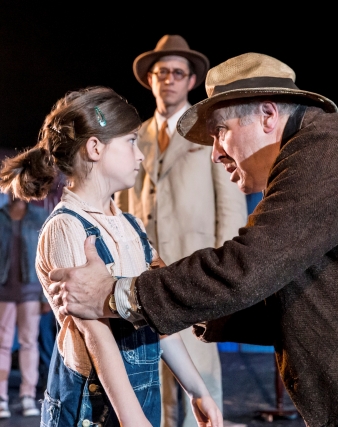The ultimate parable of racial intolerance, bigotry and injustice, in 2006 British librarians ranked Harper Lee’s To Kill A Mockingbird ahead of the Bible as one “every adult should read before they die”. It was adapted into an Oscar-winning film in 1962 starring Gregory Peck and Christopher Sergel’s stage adaptation has been performed all over the world and in Monroeville, Alabama, the setting for the novel, every year since 1990.
The full house in the Theatre Royal saved its biggest cheer for the children who starred in tonight’s show presented by the Regent’s Park Open Air Company. It is through the eyes of a (white) lawyer’s son and daughter that we have experienced their raw sense of incredulity at a perverse verdict handed down by a prejudiced jury in the southern states of America. Scout and Jem witness their widowed father, Atticus Finch, fail to defend the unlucky Tom Robinson, who is wrongly accused of raping a white girl, and rail against the injustice served to an innocent.
On the night Ava Potter as Scout pretty much stole the show – always feisty and clearly irrepressible she engaged the audience more than most, and certainly was more convincing than the lynch mob who came to string Tom up! Contrary to Noel Coward’s advice to Mrs Worthington, I would put your daughter on the stage Mrs Potter! Arthur Franks played her brother Jem’s pent up frustration to perfection and Connor Brundish oozed confidence as their young friend Dill. Ava’s Scout stood out as the perfect foil to her father’s more measured, dry resolve. Daniel Betts’ quiet intelligent style as Atticus grew throughout the performance and in the moment he leaves the court with the (imagined) black Americans in the court house standing in respect of his attempts to clear one of their own, hairs stand on the back of your neck.
Directed by Timothy Sheader, the production has been influenced by the story-telling programme Pin Drop at the Simon Oldfield gallery in London. Sheader has sought to unite players and audience in a combined experience of a tale shared out-loud. When the play begins the whole cast is assembled at the front of the stage, each with a copy of the book. In turn they read to us. Throughout the quieter scene setting of the first act this served as a frequent device for carrying the narrative. In a smaller venue this might have been more effective. Whereas the strength in the single narrator’s role in Under Milk Wood was a central and unifying element in that piece, here so many different voices, and not all of them with quite enough resonance to carry, rather flattened the dramatic effect. But aided by Oliver Fenwick’s distinctly warm-palette lighting, a southern country atmosphere was conjured by the excellent Phil King, who provided a haunting background throughout with ukulele, guitar, harmonica and voice.
Drawing on the design of the original book cover, the stage set by Jon Bausor comprised a single tree in leaf. The ensemble mapped out the features of the town in chalk on the floor in front of a simple background wall of corrugated iron panels which were lit in a golden summer light.
The second act, the trial of Tom Robinson, saw a marked upping of dramatic engagement. There were strong performances from Zackary Momoh as the hapless Tom and David Carlyle as prosecuting lawyer Mr Gilmer. Ryan Pope gave a livid portrayal of the bigot Bob Ewell. As onlookers, the audience becomes the jury, and experience Atticus’s advice to his daughter Scout: “you never really understand a person until you consider things from his point of view – until you climb around in his skin and walk around in it.”
A play for our time? To read or see To Kill… before we die? Yes I think so. It is an historical imperative. It will always work as a timely reminder that blind-eyed narratives about race can lead to travesties of justice and equality. ★★★☆☆ Simon Bishop 13/01/15


